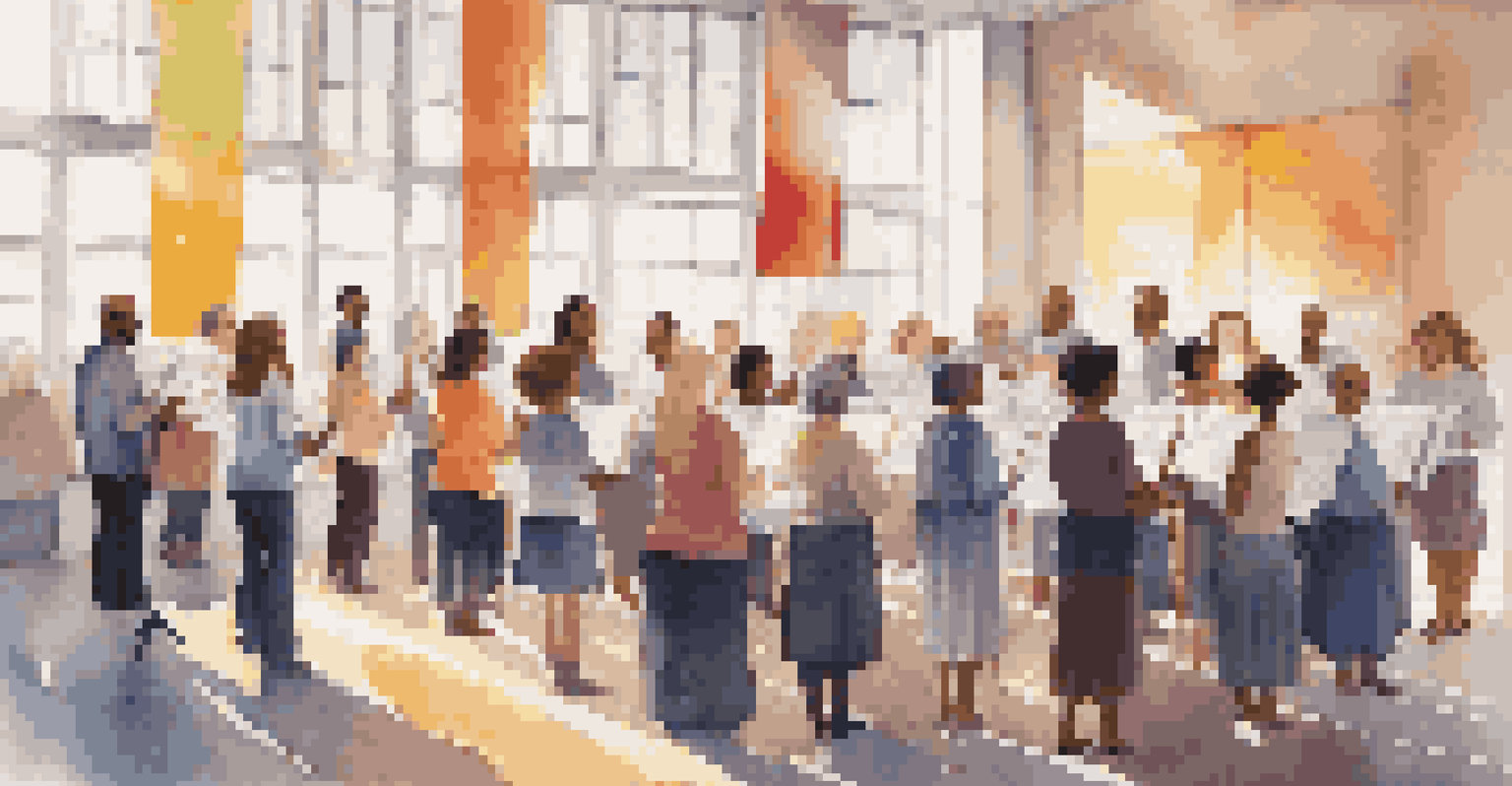The Art of Transcribing Music for Choirs

Understanding the Basics of Music Transcription
Transcribing music involves converting audio into written notation, a skill essential for choir directors and arrangers. This process allows singers to read and perform music accurately, ensuring a cohesive sound. Understanding the fundamentals of musical notation, such as staff, clefs, and note values, is crucial for anyone embarking on this task.
Music is the shorthand of emotion.
Think of transcribing as translating a spoken language into written words; both require a deep understanding of structure and meaning. For choirs, effective transcription means considering vocal parts, harmonies, and dynamics. It’s not just about writing down notes, but capturing the essence of the piece to inspire performers.
As you begin your transcription journey, familiarize yourself with various instruments and their ranges. This knowledge will help you allocate parts appropriately among singers, ensuring that each voice type is utilized effectively. By grasping these basics, you lay a solid groundwork for more advanced transcription techniques.
Choosing the Right Music for Transcription
Selecting the right piece for transcription is key to a successful choir performance. Consider the skill level of your choir; a challenging piece can be exhilarating but may lead to frustration if it's too complex. Balance is crucial; aim for music that stretches their abilities while remaining achievable.

Moreover, think about the style and genre that resonate with your choir’s strengths. For instance, a gospel choir might shine with soulful arrangements, while a classical choir could excel with intricate harmonies. Choosing music that aligns with the choir’s identity enhances engagement and performance quality.
Importance of Music Transcription
Transcribing music is essential for choirs as it allows singers to perform accurately and cohesively.
Listening attentively to the original piece is vital, as it allows you to understand its nuances and emotional impact. Pay attention to elements like tempo, dynamics, and phrasing, which will inform your transcription. This careful selection process ensures that the music you choose will inspire both the singers and the audience.
Analyzing the Original Piece Before Transcribing
Before diving into transcription, take the time to analyze the original piece thoroughly. Listen multiple times, focusing on different elements each time—melody, harmony, rhythm, and texture. This step is akin to studying a blueprint before constructing a building; it provides a clear vision of what you’ll create.
Transcription is the art of capturing the essence of music, transforming sound into a visual form that can be shared and performed.
Taking notes during your analysis can be invaluable. Jot down key changes in dynamics, important motifs, and any recurring themes. These notes will serve as your roadmap during the transcription process, helping you capture the piece's essence accurately.
Additionally, consider the emotional journey the music conveys. Understanding the composer’s intent and the piece's context can inform your transcription style. By grasping the original's emotional depth, you can create a transcription that resonates with both the choir and its audience.
Transcribing Vocal Parts: Tips and Techniques
When transcribing vocal parts, clarity is paramount. Start by identifying the main melody and then layer in harmonies and counter-melodies for a fuller sound. Use software or handwritten notation to visualize these parts clearly, ensuring each voice is distinct yet harmonious.
Consider the range of each voice part as you transcribe. Sopranos might handle higher melodies, while altos and tenors fill in the middle harmonies. Carefully distributing vocal lines based on each singer's strengths ensures a balanced and powerful choir sound.
Selecting Appropriate Music
Choosing the right piece for transcription is crucial, as it should match the choir's skill level and resonate with their strengths.
Don’t forget about dynamics and phrasing; these elements breathe life into your transcription. Mark where the choir should swell or soften, and indicate breath marks where necessary. These details guide the performers, enhancing their connection to the music and each other.
Incorporating Dynamics and Articulations in Your Transcription
Dynamics and articulations are the emotional heart of any musical piece. When transcribing, it’s essential to include notations for crescendos, decrescendos, and accents, as these guide the performers in expressing the music's emotion. Think of dynamics as the color palette in a painting; they add depth and vibrancy to your transcription.
Use standard symbols for dynamics, such as 'p' for piano (soft) and 'f' for forte (loud), to maintain clarity. Additionally, consider adding performance markings like staccato or legato to specify how notes should be played. This attention to detail enhances the choir's overall performance.
As you work on these elements, remember the context of the piece. Some genres may require more dramatic dynamics, while others may benefit from subtlety. By tailoring your dynamic markings to the music’s style, you create a transcription that truly reflects its essence.
Editing and Refining Your Transcription
Once you’ve completed your initial transcription, the editing phase begins. This is where you refine your work, ensuring clarity and accuracy. It’s helpful to play through the transcription on an instrument or use software to hear how it sounds, allowing you to catch any discrepancies.
During this phase, consider seeking feedback from colleagues or experienced musicians. Fresh ears can provide valuable insights and highlight areas that might need adjustment. Collaboration often leads to improvements you might not have considered, enhancing the final product.
Engaging Choir in Rehearsals
Preparing the choir for performance involves breaking down challenging sections, encouraging communication, and fostering emotional connections with the music.
Lastly, remember that perfection is a journey, not a destination. Be open to revisiting your work, making adjustments as needed. This iterative process helps you grow as a transcriber and results in a more polished and effective transcription for your choir.
Preparing Your Choir for the Transcribed Piece
Once your transcription is polished, it’s time to prepare your choir for performance. Start by distributing copies of the transcription well in advance, allowing singers to familiarize themselves with the music. This preparation sets the stage for a successful rehearsal process.
During rehearsals, focus on sections that may pose challenges, breaking them down into manageable parts. Encourage singers to ask questions and express concerns; open communication fosters a collaborative atmosphere. This approach not only aids learning but also builds camaraderie within the choir.

As you progress, incorporate elements of interpretation and expression into your rehearsals. Discuss the emotional context of the piece and encourage singers to connect personally with the music. This engagement can elevate a performance from merely technical to a heartfelt expression of art.
Celebrating Your Choir's Performance and Growth
After the performance, take a moment to celebrate your choir’s hard work and dedication. Acknowledge the effort that went into learning a new piece, regardless of the outcome. This recognition fosters a positive environment and encourages continued growth and exploration in music.
Consider holding a feedback session where singers can share their experiences and insights from the performance. This reflection not only reinforces what they’ve learned but also builds a sense of community within the choir. It’s through shared experiences that growth truly happens.
Finally, look ahead to future transcriptions and performances. Encourage your choir to embrace new challenges, whether that means tackling more complex pieces or exploring different genres. By fostering a culture of curiosity and enthusiasm, you’ll cultivate a thriving, dynamic choir.